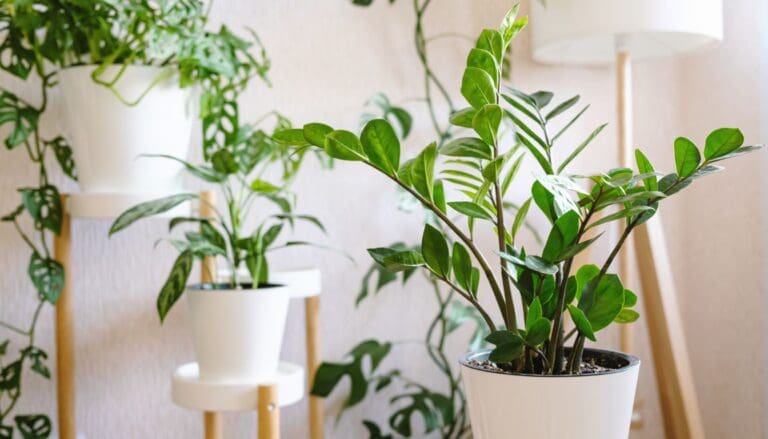11 Common Winter Houseplant Problems (And How to Fix Them)
Keeping houseplants happy in winter can honestly feel like a bit of a puzzle.
Shorter days, dry indoor air, and those sudden temperature swings make it tough for plants to really settle in.
Winter brings all sorts of weird issues, but most of them have a straightforward fix if you know what to look for.
I’ve had my fair share of droopy leaves, stubborn dry soil, and even the occasional pest invasion once the cold sets in.
Here’s what’s actually worked for me when it comes to the most common winter plant problems.
Hopefully, this helps you keep your green friends thriving until spring rolls around.
Please note: Simplify Plants is reader-supported. As an Amazon Associate, I earn from qualifying purchases made by our readers with no extra cost added to you all! Some links in the post are affiliate links and I get a commission from purchases made through links in the post.
1) Brown leaf tips due to dry air – increase humidity with a humidifier

Every winter, I spot those annoying brown tips on my houseplants. The heater keeps me warm, but it just sucks all the moisture out of the air, leaving my plants a little stressed.
A humidifier near my plants is pretty much my go-to fix. I don’t run it constantly, just a few hours here and there, and it really helps the leaves stay green.
Sometimes I’ll group a few plants together so they can share the extra humidity. I also like putting a tray of water with stones underneath the pots—when the water evaporates, it boosts the moisture right where the plants need it.
Misting? I’ve tried it, but honestly, the water dries up too fast to make a difference. A humidifier gives much more reliable results, and my plants definitely look happier.
2) Yellowing leaves from overwatering – let soil dry out between waterings

If I see my plant’s leaves turning yellow, it’s almost always because I got carried away with the watering can. Roots need to breathe, and soggy soil just won’t let that happen.
To fix this, I let the soil dry out before watering again. I stick my finger in about an inch—if it’s still damp, I give it a few more days.
Drainage holes are a must for me. If extra water can’t escape, it just sits there and causes trouble.
In winter, plants slow down, so they don’t need as much water. I try to remind myself to hold back and only water when the soil actually feels dry.
3) Wilting plants from underwatering – water deeply and regularly

Sometimes I get busy and forget to water, and then my plants start to droop and wilt. The leaves get floppy, and the soil is bone dry.
To revive them, I water deeply so the roots get a real drink. Just splashing the top doesn’t do much, so I pour slowly until I see water draining out.
I check the soil regularly by sticking my finger in about two inches. If it’s dry, it’s time to water.
Even though plants grow slower in winter, I try to keep a routine and adjust based on how dry the soil feels. A steady schedule helps avoid both underwatering and overwatering.
When I’m consistent, my plants perk up and look much healthier. Deep, regular watering really makes a difference during the colder months.
4) Leaf drop caused by cold drafts – move plants away from windows

I’ve seen my plants lose leaves when they’re too close to a drafty window in winter. That cold air sneaks in and stresses them out.
Moving my plants just a few feet away from windows and doors helps keep them stable. Even a little shift away from the cold makes a difference.
I check for chilly drafts and seal up any gaps I find. Sometimes I’ll use a curtain to block the draft, or put the plants on a stand or table instead of right on the sill.
Since making these changes, I’ve had way fewer leaves dropping and my plants seem a lot happier.
5) Pests like spider mites – wipe leaves and use insecticidal soap

Dry winter air seems to attract tiny spider mites to my houseplants. They leave little webs and yellow spots that are honestly pretty gross.
When I see them, I grab a damp cloth and wipe the leaves to get rid of as many as I can. It’s a simple step, but it helps right away.
After that, I spray the leaves (top and bottom) with insecticidal soap. Mites love to hide underneath, so I don’t skip that part.
I repeat the treatment every few days until they’re gone. Keeping things consistent really matters here.
To make life harder for spider mites, I try to keep the air a bit more humid. Even a small humidifier or a tray of water helps.
6) Powdery mildew on leaves – improve air circulation and avoid overhead watering

Every so often, I’ll spot a white, powdery coating on my plant’s leaves in winter. That’s powdery mildew, and it can spread fast if I don’t do something.
I space my plants out so air can move around them, and sometimes I run a small fan on low. Keeping the air from getting too still really helps.
I also avoid overhead watering because wet leaves are basically an invitation for mildew. I water right at the soil instead.
If mildew shows up, I gently wipe the leaves with a damp cloth. Sometimes I’ll try a mild water and baking soda mix, but I always test it on a single leaf first.
I keep an eye on humidity, too. Too much dampness isn’t great, so I try to find a balance. Giving plants space and airflow keeps mildew from taking over.
7) Leggy growth from low light – move plants to brighter spots

When winter hits, my plants sometimes get all stretched out and spindly. The stems lean toward the window, and the leaves get smaller—classic not enough light situation.
I move them as close as I can to a sunny window, usually south or east-facing. I make sure the leaves don’t actually touch the cold glass, though.
If natural light isn’t cutting it, I’ll use a grow light for a few hours. It doesn’t have to be fancy—just enough to keep them from stretching.
Rotating the pots every week helps, too. That way, the plant grows evenly instead of leaning all to one side.
With better light, my plants look fuller and a lot less awkward.
8) Root rot from poor drainage – repot with fresh, well-draining soil

Root rot has killed more of my plants than I’d like to admit. It always comes down to too much water and not enough drainage.
If I notice roots that are brown, mushy, or smell bad, I trim away the damaged parts with clean scissors. Gotta give the plant a fresh start.
I repot using fresh, well-draining soil—something with perlite or sand works great. Water needs to flow through easily.
Drainage holes are non-negotiable for me. If the pot doesn’t have one, I switch it out, no questions asked.
After repotting, I water lightly and let the plant settle in. I always wait for the top layer of soil to dry before watering again. It’s a simple habit, but it keeps roots healthy.
9) Salt buildup on soil surface – flush soil with water monthly
Every winter, I notice a white crust forming on the soil. That’s salt from tap water and leftover fertilizer, and it can really stress out my plants.
To clear it up, I flush the soil with clean water about once a month. I set the pot in the sink and pour water through until it drains out the bottom.
Drainage holes are key here, too—otherwise, you just end up with soggy roots. Sometimes I’ll scrape off the crust before flushing, just to give the plant a cleaner start.
This quick routine keeps my plants happier, and the soil stays loose instead of getting hard or crusty. It’s a small thing, but it really helps.
10) Leaf curl from temperature fluctuations – keep plants in stable environments

I’ve noticed my plants curl their leaves whenever the room temperature changes suddenly. Cold drafts, heaters, or open windows can really shock them.
Those quick shifts make the leaves twist or fold up—it’s like they’re just trying to protect themselves. To help, I keep my plants away from doors, vents, and drafty windows.
Stable environments help leaves stay healthy and prevent stress. Even a few degrees of change can mess with sensitive plants more than you’d think.
I also avoid putting plants right next to radiators or space heaters. That dry, hot air? It causes more curling, and sometimes it can even burn the leaves.
Just giving them a few feet of space usually does the trick. If my place gets chilly at night, I’ll close the curtains to keep out drafts.
Consistent conditions keep plants comfortable and stop the leaves from reacting. Small changes like this actually make plant care a lot easier.
When I travel, I’ll ask someone to check on the thermostat so it doesn’t swing around too much. Keeping the temperature even helps my plants look their best all winter.
11) Sticky residue from aphids – spray with neem oil

Sometimes I spot sticky spots on my plant’s leaves or even on the table underneath. That sticky stuff is called honeydew, and it usually means aphids are feeding on the plant.
Aphids are tiny bugs that suck sap from leaves and stems. When they feed, they leave behind this residue that can attract dust or even mold.
To fix it, I spray neem oil on the leaves and stems. Neem oil coats the insects and stops them from feeding.
I always cover the undersides of the leaves, since aphids love to hide there. I’ll repeat the spray every few days until the sticky residue disappears.
If the plant is small, sometimes I just rinse it in the sink before spraying. That washes off a lot of bugs and helps the neem oil work better.
By keeping an eye out for sticky residue and treating it quickly, I can protect my plants and keep them looking healthy.
How Winter Conditions Affect Houseplants
My plants always seem to struggle more in winter. The light’s weaker, the air gets super dry, and the temperature inside just keeps shifting.
Each of those changes affects how well my plants grow and how healthy they stay.
Reduced Light and Its Impact
Shorter days and weaker sunlight make it harder for my plants to photosynthesize. I notice slower growth, pale leaves, and sometimes leaves dropping.
Plants that usually love bright light can start to look stressed when they don’t get enough. To help, I move them closer to south- or west-facing windows where they can soak up the most daylight.
If that’s still not enough, I’ll use grow lights for a few hours each day. I also rotate my pots every week so each side gets equal light.
That keeps the plants from leaning and helps them grow more evenly. Low light means I water less often too.
Since plants use less energy, their soil stays wet longer, and overwatering can lead to root rot.
Temperature Fluctuations Indoors
Indoor temperatures swing a lot in winter—at least in my place. Rooms near drafty windows or doors can get too cold, while spots near heaters get way too hot.
These shifts stress my plants and sometimes cause leaf curling or browning edges. I keep plants away from heaters, fireplaces, and vents so they don’t dry out.
At the same time, I avoid putting them right next to cold glass or drafty areas. A steady temperature between 65–75°F (18–24°C) works best for most houseplants.
At night, I make sure it doesn’t drop below 55°F, since many tropical plants just can’t handle colder air. If I can’t control drafts, I’ll use a curtain or move plants farther into the room.
This keeps them more stable and less stressed.
Changes in Humidity Levels
Winter air inside gets ridiculously dry because of heating systems. I often see crispy leaf tips, browning edges, or leaves dropping early.
Plants like ferns, calatheas, and orchids struggle most when humidity drops too low. To help, I group plants together to create a microclimate with higher moisture.
I also put a humidifier nearby, which honestly makes a big difference. Another easy trick is setting pots on trays filled with water and pebbles.
As the water evaporates, it raises humidity around the plants. I don’t mist too often because it doesn’t really help for long and can cause fungal problems.
Keeping a consistent humidity level of 40–60% helps most plants stay healthy through winter.
Preventing and Managing Winter Stress
I keep my plants healthier in winter by changing how I water them and making sure the air moves better indoors.
These small tweaks reduce stress and help them adjust to the colder, darker season.
Adjusting Watering Routines
My plants drink way less water in winter, probably because the shorter days slow their growth. If I water too often, the soil stays soggy and roots can rot.
To avoid this, I always check the top inch of soil before watering. If it feels dry, then I water.
I also use room-temperature water. Cold water can shock the roots, especially when the house is chilly.
I pour slowly so the soil absorbs it evenly instead of flooding the pot. A simple trick that helps me is keeping a watering schedule chart:
| Plant Type | Winter Watering Frequency |
|---|---|
| Succulents | Every 3–4 weeks |
| Tropical Foliage | Every 1–2 weeks |
| Flowering Plants | Weekly or as needed |
This chart keeps me from guessing and helps me avoid both overwatering and underwatering.
Improving Indoor Air Circulation
I’ve learned that stale air in winter makes plants weaker and more prone to pests. Since I can’t open windows much, I use a small fan on a low setting to keep air moving.
I place it across the room so it doesn’t blow straight on the plants. I also make sure not to crowd pots too close together.
Leaving space between them lets air flow and reduces humidity buildup that can cause mold. When heating systems dry out the air, I set up a humidifier nearby.
This balances moisture in the room while keeping circulation steady. Good airflow not only helps plants breathe better but also keeps leaves cleaner and healthier.
Frequently Asked Questions
I often deal with yellowing leaves, pests, and dry air when caring for plants in winter. Adjusting watering, light, and humidity is a must to keep them happy indoors.
Why are my houseplant’s leaves turning yellow in winter?
I notice yellow leaves when I water too often. In winter, soil dries more slowly, so I let the top inch dry before watering again.
How can I tell if I’m overwatering my plants during the colder months?
If the soil feels soggy and the leaves look soft or yellow, I know I’ve watered too much. I check the soil with my finger and only water when it feels dry.
What’s the best way to manage pest problems in indoor plants when it’s cold outside?
I wipe leaves with a damp cloth to clear dust and pests like spider mites. If I see more bugs, I use insecticidal soap to stop the problem early.
Can you give tips for maintaining proper humidity for houseplants in winter?
Dry air makes leaf tips turn brown. I run a humidifier near my plants or place water trays nearby to keep the air moist.
How should I adjust my plant care routine as the seasons change to winter?
I move plants away from cold drafts and windows. I also water less often since growth slows down in cooler months.
What are some signs that my houseplants are not getting enough light during shorter winter days?
If you notice your plants reaching or leaning toward the window, that’s usually a hint they’re craving more sunlight.
Leaves might start looking a bit pale or washed out, too—never a great sign.
I like to move mine closer to the brightest spot I can find, or sometimes I’ll just plug in a grow light and hope for the best.
Recommended Garden Supplies
| Product Image | Our Recommended Gardening Supplies | Check Offers! |
|---|---|---|
Top Top
Top
Top
Top
Top
Top
Top
Top | rePotme Houseplant and Tropical Classic Potting Soil Mix | Check Offer On Amazon |
 Top
Top
Top
Top
Top
Top
Top
Top | Espoma Organic Indoor Plant Food | Check Offer On Amazon |
 Top
Top
Top
Top
Top
Top
Top
Top | GooingTop LED Grow Light 6000K Full Spectrum Clip Plant Growing Lamp | Check Offer On Amazon |
 Top
Top
Top
Top
Top
Top
Top
Top | Soil Moisture Meter | Check Offer On Amazon |
 Top
Top
Top
Top
Top
Top
Top
Top | Govee Hygrometer Thermometer, Bluetooth Enabled! | Check Offer On Amazon |
 Top
Top | LEVOIT Humidifiers for Large Room(Best For Plants) | Check Offer On Amazon |
 Top
Top
Top
Top
Top
Top
Top
Top | Upgraded DIY Automatic Drip Irrigation Kit, 15 Potted Houseplants Support | Check Offer On Amazon |
 Top
Top
Top
Top
Top
Top
Top
Top | Stainless Steel Heavy Duty Gardening Tool Set | Check Offer On Amazon |
 Top
Top
Top
Top
Top
Top
Top
Top | Bonide Insecticidal Soap | Check Offer On Amazon |
 Top
Top
Top
Top
Top
Top
Top
Top | Bonide 32 oz Spray Neem Oil for Organic Gardening | Check Offer On Amazon |
 Top
Top
Top
Top
Top
Top
Top
Top | Garden Safe Fungicide | Check Offer On Amazon |






